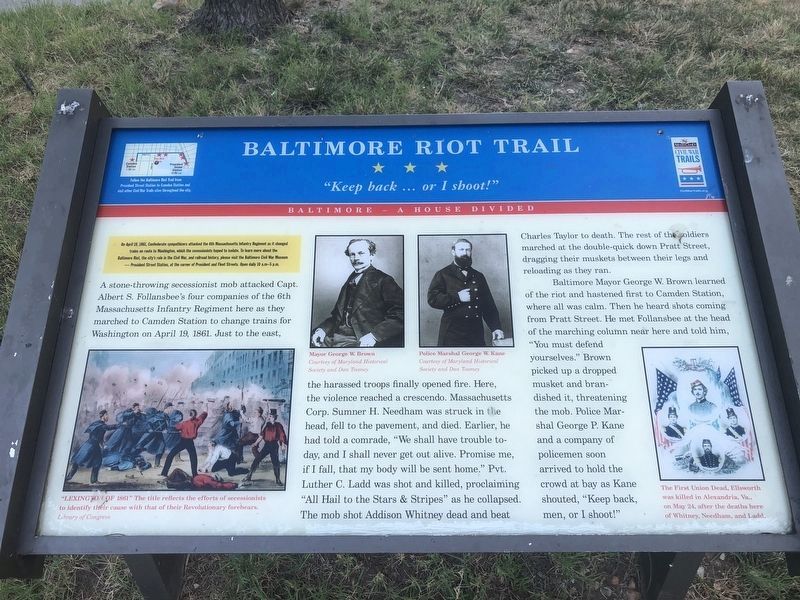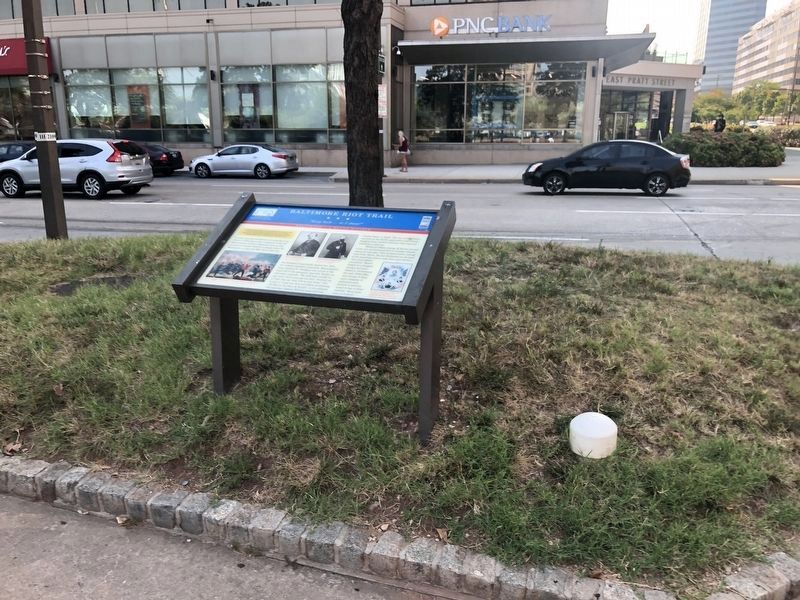Inner Harbor in Baltimore, Maryland — The American Northeast (Mid-Atlantic)
Baltimore Riot Trail
"Keep back … or I Shoot"
— Baltimore - A House Divided —
On April 19, 1861, Confederate sympathizers attacked the 6th Massachusetts Infantry Regiment as it changed trains en route to Washington, which the secessionists hoped to isolate. To learn more about the Baltimore Riot, the city's role in the Civil War, and railroad history, please visit the Baltimore Civil War Museum - President Street Station, at the corner of President and Fleet Streets. Open daily 10 a.m - 5 p.m.
A stone-throwing secessionist mob attacked Capt. Albert S. Follansbee's four companies of the 6th Massachusetts Infantry Regiment here as they marched to Camden Station to change trains for Washington on April 19, 1861. Just to the east, the harassed troops finally opened fire. Here, the violence reached a crescendo. Massachusetts Corp Sumner H. Needham was struck in the head, fell to the pavement, and died. Earlier, he told a comrade, "We shall have trouble today, and I shall never get out alive. Promise me, if I fall, that my body will be sent home." Pvt. Luther C. Ladd was shot and killed, proclaiming "All Hail to the Stars & Stripes" as he collapsed. The mob shot Addison Whitney dead and beat Charles Taylor to death. The rest of the soldiers marched at the double-quick down Pratt Street, dragging their muskets between their legs and reloading as they ran.
Baltimore Mayor George W. Brown learned of the riot and hastened first to Camden Station, where all was calm. Then he heard shots coming from Pratt Street. He met Follansbee at the head of the marching column near here and told him, "You must defend yourselves." Brown picked up a dropped musked and brandished it, threatening the mob. Police Marshall George P. Kane and a company of policemen soon arrived to hold the crowd at bay as Kane shouted, "Keep back, men, or I shoot!"
Erected by Maryland Civil War Trails.
Topics and series. This historical marker is listed in this topic list: War, US Civil. In addition, it is included in the Maryland Civil War Trails series list. A significant historical month for this entry is April 1862.
Location. This marker has been replaced by another marker nearby. It was located near 39° 17.178′ N, 76° 36.803′ W. Marker was in Baltimore, Maryland. It was in the Inner Harbor. Marker was at the intersection of Light Street (Maryland Route 2) and East Pratt Street, on the left when traveling south on Light Street. Touch for map. Marker was in this post office area: Baltimore MD 21202, United States of America. Touch for directions.
Other nearby markers. At least 8 other markers are within walking distance of this location. A different marker also named Baltimore Riot Trail (a few steps from this marker); Theodore R. McKeldin (a few steps from this marker); McKeldin Square
More about this marker. The marker features two photographs and two illustrations. The photographs are of Mayor George W. Brown and Police Marshall of George W. Kane.
One illustration has the following caption:
"Lexington of 1861" The title reflects the efforts of secessionists to identify their cause with that of their Revolutionary forebears.
The other illustration is labeled as follows:
The First Union Dead, Ellsworth was killed in Alexandria, Va., on May 24, after the deaths here of Whitney, Needham, and Ladd.
Related marker. Click here for another marker that is related to this marker. This marker has been replaced with the linked marker.
Credits. This page was last revised on April 3, 2023. It was originally submitted on March 12, 2008, by Christopher Busta-Peck of Shaker Heights, Ohio. This page has been viewed 3,109 times since then and 13 times this year. Photos: 1, 2. submitted on August 8, 2021, by Devry Becker Jones of Washington, District of Columbia.

